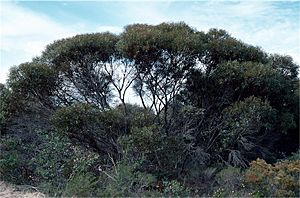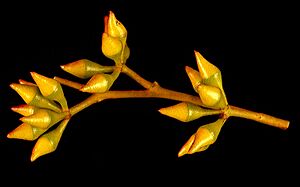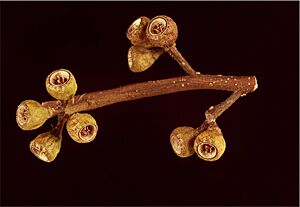Fremantle mallee facts for kids
Quick facts for kids Fremantle mallee |
|
|---|---|
 |
|
| Eucalyptus foecunda at Wabling Hill, Western Australia | |
| Scientific classification | |
| Genus: |
Eucalyptus
|
| Species: |
foecunda
|
The Eucalyptus foecunda, also known as the Fremantle mallee or narrow-leaved red mallee, is a type of plant in the myrtle family. This plant is special because it grows only in Western Australia.
It has rough bark on its lower trunk and smooth bark higher up. Its adult leaves are long and narrow, shaped like a spear. The plant produces groups of nine or eleven creamy white flower buds. When these flowers bloom, they are also creamy white. After flowering, it grows cup-shaped fruits. This plant was once thought to be the same as the more common Eucalyptus leptophylla.
Contents
What Does it Look Like?
The Eucalyptus foecunda is usually a mallee, which means it's a shrubby tree with many stems growing from the ground. It typically grows to about 3 metres (10 feet) tall. Sometimes, it can even grow into a small tree up to 5 metres (16 feet) high. It has a special woody swelling at its base called a lignotuber. This helps the plant regrow after fires.
The bark at the bottom of the plant is flaky. Higher up, the bark is smooth and can be grey or reddish-brown.
Leaves
Young plants and new shoots have dull green leaves. These leaves are shaped like an oval or a spear. They are usually 40-80 mm (1.6-3.1 inches) long and 2-20 mm (0.08-0.8 inches) wide.
Adult leaves are narrow and glossy green on both sides. They are typically 50-95 mm (2-3.7 inches) long and 5-13 mm (0.2-0.5 inches) wide. These leaves grow on a stalk called a petiole, which is 5-17 mm (0.2-0.7 inches) long.
Flowers and Fruit
The flower buds grow in the leaf axils (where the leaf meets the stem). They appear in groups of nine or eleven. These groups are on an unbranched stalk called a peduncle, which is 5-13 mm (0.2-0.5 inches) long. Each individual bud has a small stalk called a pedicel, 2-5 mm (0.08-0.2 inches) long.
Mature buds are oval or spindle-shaped. They are 6-10 mm (0.2-0.4 inches) long and 3-4 mm (0.1-0.2 inches) wide. They have a cone-shaped or beaked cap called an operculum, which is 2.5-6 mm (0.1-0.2 inches) long.
The Eucalyptus foecunda usually flowers in August or from January to February. Its flowers are a lovely creamy white colour. After the flowers, the plant produces a woody, cup-shaped fruit. This fruit is a capsule, about 4-6 mm (0.16-0.24 inches) long and wide.
How it Was Named
The Eucalyptus foecunda was first officially described in 1844. This description was made by a scientist named Johannes Conrad Schauer. He published it in a book called Plantae Preissianae. The plant he described was found near Fremantle.
The second part of its scientific name, foecunda, means "prolific" or "fruitful." This name was chosen because the plant produces many flowers.
Where it Lives
The narrow-leaved red mallee grows in sandy areas near the coast of Western Australia. You can find it between Lancelin and Mandurah. It prefers to grow in sandy soil that contains lime.
Conservation Status
The Western Australian Government's Department of Parks and Wildlife has classified this eucalypt as "not threatened." This means it is not currently at risk of disappearing.
Images for kids





